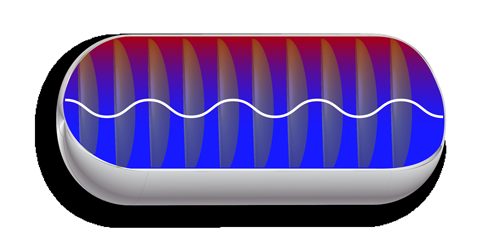Weighing gas with sound and microwaves

NIST scientists have developed a novel method to rapidly and accurately calibrate gas flow meters, such as those used to measure natural gas flowing in pipelines, by applying a fundamental physical principle: When a sound wave travels through a gas containing temperature gradients, the sound wave's average speed is determined by the average temperature of the gas.
Accurate calibrations of gas flow meters issues are of urgent interest to meter manufacturers and calibration labs, with potential impact throughout the natural gas industry.
Conventional calibrations are typically conducted during measured time intervals by flowing a gas stream through the meter being calibrated. The quantity of gas that passes through the meter is determined by collecting the gas in a large tank and measuring its average temperature and pressure, which in turn reveals the amount of gas.
However, the process of collecting the gas in large tanks generates temperature gradients (different temperatures in different parts of the tank), which make the average difficult to measure. Those gradients persist for hours or days. Thus a fast reading is inherently inaccurate.
To get around that problem, current practice entails calibrating many small meters, one at a time, and then using them in parallel to calibrate a larger meter. This produces a more accurate reading, but is inherently time-consuming, and therefore expensive.
NIST's innovation replaces the difficult problem of accurately measuring the average temperature of a large volume of gas with the easier problem of accurately measuring the average speed-of-sound in the gas.
In one recent paper, NIST researchers deduced the internal shape, thermal expansion, and volume of a 300 liter collection tank by measuring which microwave frequencies resonated (formed standing waves) within the evacuated tank.
In a second set of experiments, described in a forthcoming paper, they filled the tank with argon gas and measured the frequencies of the acoustic resonances. From the frequencies and the pressure, they deduced the mass of the argon in the tank.
Finally, they heated the top of the tank to establish a temperature difference across the gas of 4 % of the average gas temperature. The temperature difference changed the acoustic resonance frequencies and the pressure; however, the mass of the argon, as deduced from the frequencies and the pressure was unchanged within 0.01 %.
This result implies that the acoustic resonance technique could be used to measure the collected gas, even in the presence of a temperature gradient, such as those that occur in a much larger tanks located outside the well-controlled environment of a laboratory.
More information: "Microwave determination of the volume of a pressure vessel." M R Moldover et al 2015 Meas. Sci. Technol. 26 015304 DOI: 10.1088/0957-0233/26/1/015304
Provided by National Institute of Standards and Technology


















